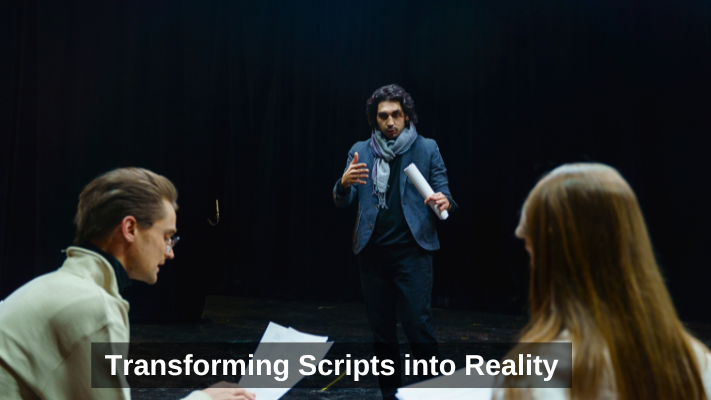Have you ever wondered how movies come to life on the big screen? It’s an amazing process that involves the creative minds of directors, actors, and the whole production team. As a movie fan, you’ve probably been drawn in by the performances and the magic of the cinema. But do you know about the hard work and dedication that happens behind the scenes?
In this article, we’ll take you on a journey into the fascinating world of transforming scripts into reality. We’ll hear from experienced directors and talented actors who will share their insights, techniques, and the challenges they face in bringing a script to life.
The Director’s Vision: Bringing the Written Word to the Screen
The director is the visionary behind the scenes. Their job is to take the written script and turn it into a powerful, emotional story on screen.
Steven Spielberg, a famous director, explains: “When I read a script, I see it, hear it, and feel it. My job is to take that vision and make it real on the screen.”
Directors need to deeply understand the script, the characters, and the overall story. They work closely with the screenwriter to make sure the script’s vision matches their own. This teamwork is crucial in shaping the final movie.
Ava DuVernay, known for her powerful social-issue films, shares her approach: “I read the script and see the world, the characters, and the emotions. Then, I work hard to translate that vision into every frame, every shot, every performance.”
Casting: Finding the Right Actors
One of the director’s most important jobs is casting. They must find the perfect actors to bring the characters to life and connect with the audience.
Denzel Washington, a famous actor and director, says: “The right actor can make a script even better. They bring the characters to life and make them feel real and relatable.”
Directors often hold many auditions, looking for actors who have the skills and also understand the character’s emotions. This can be challenging, but finding the perfect fit is incredibly rewarding.
Greta Gerwig, the director of “Little Women,” explains: “I don’t just look for acting talent. I want to see the actor’s soul in their performance. I want to feel the character’s joy, pain, and struggles as if they’re my own.”
The Actor’s Craft: Transforming into the Character
For actors, transforming a script into reality is a very personal and demanding process. They must understand the character’s thoughts, fears, and desires to deliver a captivating performance.
Meryl Streep, one of the greatest actors, shares: “I don’t just memorize lines. I become the character. I live their life, feel their emotions, and make their choices as if they were my own.”
Actors spend countless hours researching, practicing, and even changing their appearance to truly embody their characters. This dedication is what makes their performances so powerful.
Daniel Day-Lewis, known for his method acting, explains: “I don’t just play a character; I become them. I immerse myself in their world until I can’t tell where I end and the character begins.”
Collaboration: Director and Actor Work Together
The relationship between the director and the actor is crucial in transforming a script into reality. It’s a balance of creative vision, trust, and open communication.
Viola Davis, a famous actress, says: “A good director is like a partner, guiding me and challenging me to push my performance further. They help me unlock the true essence of the character.”
Directors rely on their actors to bring their vision to life. Christopher Nolan, the director of “Inception,” emphasizes this collaboration: “The director provides the framework, but the actor is the one who brings it to life. Together, we create something truly magical.”
The Challenges of Transforming Scripts into Reality
While transforming scripts into reality can be rewarding, it also has its challenges. Directors and actors face obstacles, from logistical issues to emotional and creative barriers.
Chadwick Boseman, the late actor, spoke about the difficulties of bringing a character to life: “It’s not just about memorizing lines or hitting your marks. It’s about finding the humanity in the character, the small details that make them feel real.”
Ava DuVernay adds, “Budgets, schedules, and resources can all be problems, but the biggest challenge is staying true to the script’s vision while also allowing room for creative exploration.”
Conclusion: The Magic of Transforming Scripts into Reality
The process of transforming scripts into reality is a testament to collaboration, creativity, and dedication. Directors, actors, and the entire production team work tirelessly to bring the written word to life, creating movies that captivate audiences.
As a movie lover, you now have a deeper appreciation for the craft behind this process. The next time you watch a film, pay attention to the performances, the cinematography, and the storytelling. Remember the hard work, the emotional journeys, and the creative visions that come together to create the magic you see on the screen.
So, what’s your favorite movie or performance that has left a lasting impression on you? Post your ideas and personal stories in the comments section below! And who knows, maybe one day, you’ll be the one transforming a script into a cinematic masterpiece.
